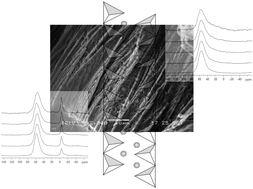MAS-NMR studies of glasses and glass-ceramics based on a clinopyroxene–fluorapatite system†
Abstract
Glasses and glass-ceramics based on the ternary system CaMgSi2O6–NaAlSi2O6–Ca5(PO4)3F (diopside (

* Corresponding authors
a Glass Research Department, National Research Centre, El-Behoos St., Dokki, Cairo, Egypt
b Department of Materials, Imperial College London, South Kensington Campus, London, UK
c
Department of Chemistry, Imperial College London, South Kensington Campus, Exhibition Road, London, UK
E-mail:
r.law@imperial.ac.uk
Fax: +44 (020) 75945804
Tel: +44 (020) 75945860
d
Institute of Dentistry, Unit of Dental Physical Sciences, Barts and The London School of Medicine and Dentistry, Mile End, Mile End Road, London, UK
E-mail:
n.karpukhina@qmul.ac.uk
Tel: +44 (020) 78827409
Glasses and glass-ceramics based on the ternary system CaMgSi2O6–NaAlSi2O6–Ca5(PO4)3F (diopside (

 Please wait while we load your content...
Something went wrong. Try again?
Please wait while we load your content...
Something went wrong. Try again?
H. A. Abo-Mosallam, R. G. Hill, N. Karpukhina and R. V. Law, J. Mater. Chem., 2010, 20, 790 DOI: 10.1039/B915573B
To request permission to reproduce material from this article, please go to the Copyright Clearance Center request page.
If you are an author contributing to an RSC publication, you do not need to request permission provided correct acknowledgement is given.
If you are the author of this article, you do not need to request permission to reproduce figures and diagrams provided correct acknowledgement is given. If you want to reproduce the whole article in a third-party publication (excluding your thesis/dissertation for which permission is not required) please go to the Copyright Clearance Center request page.
Read more about how to correctly acknowledge RSC content.
 Fetching data from CrossRef.
Fetching data from CrossRef.
This may take some time to load.
Loading related content
